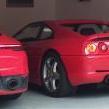-
Willkommen bei Carpassion.com
Europas großem Sportwagen-Forum.
Aktuell können Sie als Gast bereits gewisse Beiträge und Inhalte sehen.
Möchten Sie jedoch Zugang zu weiteren exklusiven Inhalten oder sich mit anderen Sportwagen-Fahrern austauschen, können Sie sich völlig kostenlos und unverbindlich bei uns neu anmelden.
-
Marktplatz
-
Vieldiskutiert
-

(1).jpg.b0cdc13dd3fe7dfd12fd9c10a45d57f3.thumb.jpg.d9a81d42128f08b75ce16bc9d4e8a5e4.jpg)


Empfohlene Beiträge
Archiviert
Dieses Thema ist archiviert und für weitere Antworten gesperrt. Erstelle doch dein eigenes Thema im passenden Forum.